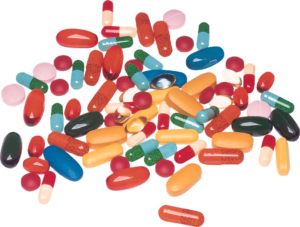 Flux, or periostitis, refers to inflammatory diseases of the oral cavity, which is manifested by purulent formation in the periosteum of the upper or lower jaw in the form of a cone.
Flux, or periostitis, refers to inflammatory diseases of the oral cavity, which is manifested by purulent formation in the periosteum of the upper or lower jaw in the form of a cone.
The cause may be mechanical damage to the tissues of the oral cavity, the lack of treatment of caries, periodontitis, pulpitis and other diseases.
Periostitis pathogens are usually streptococci or staphylococci. The clinical picture is more pronounced in adults than in older people and children.
With a visual examination on the gums, you can see a cone filled with pus. If the upper jaw is affected, edema also extends to the area under the eye, cheek, eyelid, upper lip.
When the flux is localized from below, the chin, cheek becomes edematous. One can also see a one-sided enlargement of the submaxillary lymph nodes.
Contents of
- What drugs do dentists recommend?
- Amoxicillin
- Amoxicillin
- Amoxiclav
- Ciprofloxacin
- Ampiox
- Doxycycline
- Lincomycin
- Local antibiotic therapy
- The effectiveness of conservative treatment
- Side effects of
- Features of the use of antibiotics for children
What drugs do dentists recommend?
Only a dentist can prescribe an adequate treatment, because incorrectly selected drugs can translate the disease into a chronic form.
First cut dissection and drainage of exudate. Then, the flux content is sown to determine the sensitivity of the pathogen to antibacterial drugs.
The surgical stage of flux treatment is presented in this video:
Antibiotics are mandatory for dental flux. Further, we will analyze which of them are appointed most often.
Amoxicillin
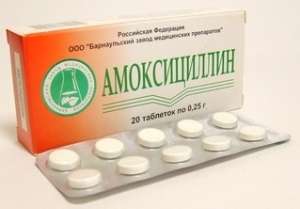 This drug belongs to the penicillin series. Highly active against microorganisms, leading to flux development. It is available in the form of a suspension, tablets and capsules.
This drug belongs to the penicillin series. Highly active against microorganisms, leading to flux development. It is available in the form of a suspension, tablets and capsules.
The use of the drug in such dosages is permitted:
- up to the age of 2 years determine the daily dose by the formula: body weight in kg multiplied by 0.02 g of the drug, divided into three doses;
- with 2 to 5 years of appoint 0.125 g for one dose three times;
- in the period of 5-10 years a day can take 0.75 grams of medication.
Adults should take 500 mg every 8 hours. With a severe form of the disease, 750-1000 mg can be taken at a time. The maximum dose is 6 g per day for adults.
It is forbidden to take medicine during lactation, patients with lymphocytic leukemia, with liver failure, dysbiosis, mononucleosis.
Drugs with a similar effect: Ecobol, Iramox, Flemoxin, Gonoform.
Amoxiclav
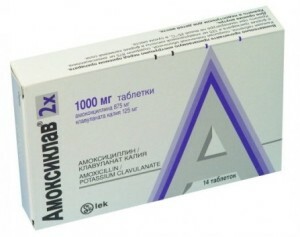 Refers to the penicillin group. It consists of clavulanic acid and amoxicillin. Due to the presence of clavulanic acid, it is active against those microorganisms that over time have become resistant to amoxicillin.
Refers to the penicillin group. It consists of clavulanic acid and amoxicillin. Due to the presence of clavulanic acid, it is active against those microorganisms that over time have become resistant to amoxicillin.
Produced in tablets and powder for injection. Take the drug at 625 mg with an interval of 8-12 hours.
Of the side effects may occur: an allergic reaction, abdominal pain, an intestinal disorder in the form of diarrhea, vomiting.
Analogues include Clamosar, Panklav, Batoklav, Augmentin.
Ciprofloxacin
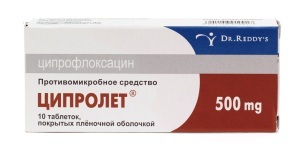 Belongs to a number of fluoroquinolones. Has a pronounced bactericidal action. Produced in tablets of 250, 500 and 750 mg.
Belongs to a number of fluoroquinolones. Has a pronounced bactericidal action. Produced in tablets of 250, 500 and 750 mg.
The dosage is determined by the physician individually depending on the weight of the patient. You can take the drug only on an empty stomach every 12 hours. During treatment, avoid prolonged exposure to sunlight due to the risk of photosensitivity.
Ciprofloxacin should not be taken with pseudomembranous colitis, pregnant and lactating mothers, children under 18 years of age.
Drugs with a similar action: Tsifran, Tsiproboy, Tsiprolet, Ciprinol.
Ampioks
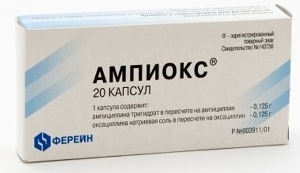 This is a combined preparation that includes ampicillin and oxacillin. Produced in the form of injections and capsules.
This is a combined preparation that includes ampicillin and oxacillin. Produced in the form of injections and capsules.
Calculation of the dose depends on the body weight of the patient and is 0.5-1.0 g for an adult 4 times a day. Use the drug is allowed from 3 years of age.
This agent is contraindicated in infectious mononucleosis, lymphocytic leukemia, hypersensitivity to the drug components.
Analogues: Oksampicin, Oksamsar, Oksamp.
Doxycycline
 Is a representative of semisynthetic tetracyclines. Produced in capsules of 100 mg. Begin the reception with 2 capsules 1 time per day, in the following days, reduce the dose to 100 mg.
Is a representative of semisynthetic tetracyclines. Produced in capsules of 100 mg. Begin the reception with 2 capsules 1 time per day, in the following days, reduce the dose to 100 mg.
This drug can not be used to treat flux in pregnant and lactating children, children under 9 years( due to the influence of tetracycline antibiotics on developing teeth), patients with hepatic insufficiency and leukopenia.
Similar agents: Unidox, Vibramycin, Doxibene, Xedocin.
Lincomycin
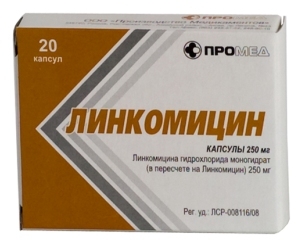 A drug from the group of lincosamides. It is available in capsules and powder for parenteral administration.
A drug from the group of lincosamides. It is available in capsules and powder for parenteral administration.
For children, the daily dose is determined from the calculation of 15-30 mg per kg of body weight and divided into two injections by intravenous route.
Adults are prescribed 500 mg 4 times a day.
Of adverse reactions, vomiting, nausea, dizziness, increased blood pressure may occur. Do not use the remedy in patients with renal and hepatic insufficiency, during lactation, during pregnancy.
The course of treatment with antibacterial agents can last from 5 to 14 days. It depends on the severity of the symptoms of the disease and the chosen drug.
Local antibiotic therapy
To accelerate the healing, extinction of inflammation, and to relieve pain, topical preparations will help:
-
 Metrogil Denta. The gel consists of chlorhexidine and metronidazole. They need to lubricate the area of flux formation three times a day. After applying at least 30 minutes, you should refrain from drinking and eating. The drug reduces pain, relieves edema, fights inflammation.
Metrogil Denta. The gel consists of chlorhexidine and metronidazole. They need to lubricate the area of flux formation three times a day. After applying at least 30 minutes, you should refrain from drinking and eating. The drug reduces pain, relieves edema, fights inflammation. - Холисал. Gel based on anti-inflammatory and antiseptic components. Apply after opening the tooth flux to reduce soreness and inflammation at the site of dissection. Apply the gel three times a day after meals.
 About the treatment of flux in the home you will learn from this article.
About the treatment of flux in the home you will learn from this article.
The effectiveness of conservative treatment
The result of treatment depends on the stage of the disease, namely the presence of pus at the site of inflammation. If the antibiotic was selected by the doctor, taking into account the sensitivity of the microflora to this drug, and the dose was correctly calculated and you observed the schedule of reception, then recovery can be expected after 5-14 days.
Side effects of
Unpleasant consequences depend on the prescribed antibiotic, but more often the following problems are observed:
-
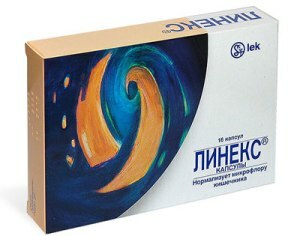 hypertension;
hypertension; - nausea, diarrhea, intestinal microflora disorder;
- dizziness;
- weakness and muscle pain;
- allergic reaction in the form of edema, itching, rashes.
To prevent disruption of the intestine, it is recommended to take lactic acid products or probiotics - preparations containing bacteria of normal intestinal microflora( Linex, Acylact).
At occurrence of any reactions nevertheless it is necessary to address to the attending physician for carrying out of correction of the appointed course.
Features of the use of antibiotics for the treatment of children
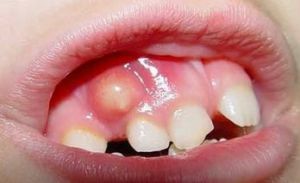
Flux in children
If you have a periostitis in a child, you should immediately contact your dentist for treatment. It will also include antibacterial agents, but their selection includes a lot of nuances.
To treat flux in children, antibiotics can be used:
- Amoxiclav .It is allowed to use from birth. Used in the form of tablets, powder for injection and suspension. Calculate the exact dosage should the doctor. Children up to 3 months of the daily norm is determined by the formula: body weight in kg, multiplied by 30 mg of the drug. The received volume is divided into two methods. A child from 3 months to 12 years is calculated as follows: 20 mg multiplied by weight in kg and divided into 3 receptions. From the age of 12, a drug with a dosage for adults is used.
- Ampiox .Up to a year, the daily dosage is determined from the calculation of 0.1-0.2 mg per kg of body weight, up to 7 years - 0.1 mg per kg of body weight, over 7 years of age - 0.05 mg per kg of body weight. The result is divided into 4-6 methods. At the age of 14, adults take an adult dosage.
- Lincomycin .It is applied from 1 month. Introduced into the body intravenously drip or orally in the form of capsules. The daily dose in infants is 10-20 mg per kg of body weight. From the age of 6, capsules are prescribed in a dose of 30 mg / kg.
- Doxycycline .This drug is not used so often. An obligatory condition to be observed when used for the treatment of periostitis in children is the age of 9 years and the body weight is not less than 40 kg.
Drugs are drunk for at least 5 days, and in severe cases, treatment can last up to 14 days. Take antibacterial drugs for children with immunosuppression is contraindicated.
